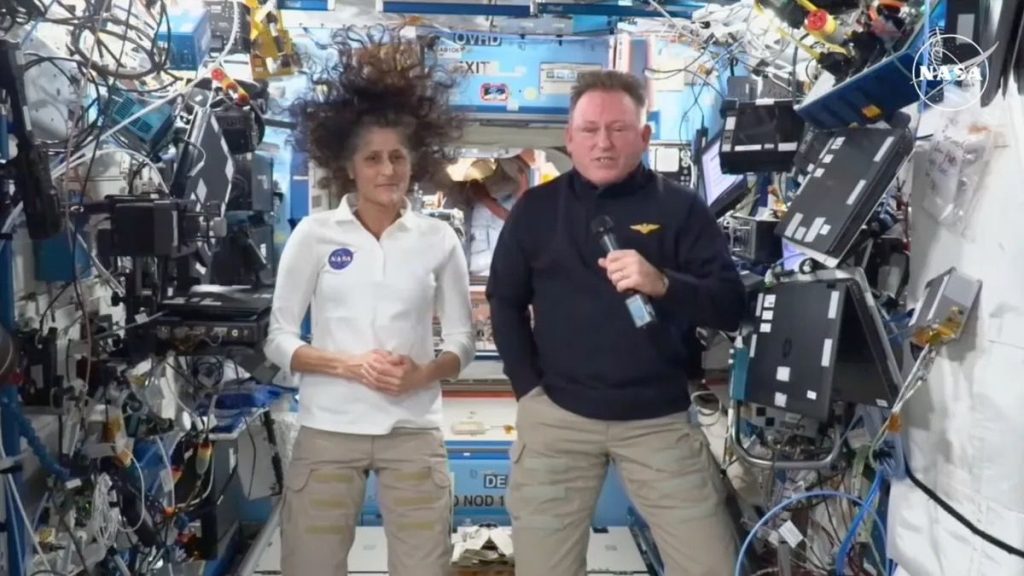Last week, media outlets like The New York Post and The Daily Mail claimed that International Space Station astronaut Suni Williams’ health was deteriorating — and on Wednesday (Nov. 13), similar conjectures were made about her fellow ISS inhabitant Butch Wilmore. In response to the assertions about Williams, both NASA and Williams herself spoke out to confirm that she’s fine. Now, in response to those rumors about Wilmore, NASA has chimed in once again.
“I’ll tell you the astronauts are in absolutely outstanding health and in good condition right now,” Dr. J.D. Polk, chief health and medical officer at NASA Headquarters in Washington, told Space.com. “So, let me just address that rumor right out the front.”
“I hope that the Chief Medical Officer of NASA is an informed and credible source — I’ll put it that way,” Dr. Polk added.
Speculation about Williams’ health seems to have been based on recent photos released by the agency. Dr. Vinay Gupta, a pulmonologist who is unaffiliated with NASA, suggested to The Daily Mail that the images show Williams’ cheeks appearing “sunken” and illustrate a person who has been “experiencing the natural stresses of living at a very high altitude, even in a pressurized cabin, for extended periods.” Both this outlet as well as The New York Post specifically say Williams looked “gaunt.” Yet, during a video interview Williams conducted aboard the ISS on Nov. 12, she said, “I’m the same weight that I was when I got up here.”
NASA’s chief medical officer reiterated that fact about the astronauts’ weight. “You’ve got fluid shift, and you’ve got astronauts that are doing aerobic activity an hour a day and resistive exercise an hour a day,” Polk said. “So, without a doubt, between that and the fluid shift, there are morphologic changes that occur that can perhaps change their appearance — but their weight has not changed, and their fitness is actually getting better.”
“I could definitely tell that weightlifting, which is not something that I do all the time, has definitely changed me,” Williams said during her video interview, referring to some of those mandated exercises astronauts perform while living in microgravity conditions for extended periods of time. “My thighs are a little bit bigger, my butt is a little bit bigger,” she said, though also stressing: “I weigh the same.”
NASA has multiple ways of ensuring astronauts remain in good health while aboard the station. “We have great insight into their exercise and their nutrition and their health,” Polk said. “The flight surgeons also do what’s called a private medical conference every week, once a week. And so, if you can imagine, they also have contact with their physician once a week.”
Dr. Polk continued to explain that the astronauts on the ISS have what’s called an “IP phone” as well, or an Internet Protocol phone: “If they have a question off-hours, sometimes they’ll just pick up the phone and call, so we’ve got tremendous insight into their health and their exercise and their diet.”
With regard to speculation about Wilmore, The New York Post published an article on Nov. 13 titled “NASA monitoring second stranded astronaut’s possible weight loss after raising alarm about colleague Sunita Williams’ health.”
According to the outlet, an unnamed NASA employee who is “involved with the mission” said that Wilmore “has also been losing body mass.” The source apparently added that, because Wilmore “had a lot more mass at the start,” it’s not “as big of a deal.” In this article, The New York Post again states that Williams looked “jarringly gaunt” in the released photos, and includes one image of Williams with a caption claiming that NASA is “working to help astronaut Sunita Williams put on pounds after she had significant weight loss.”
Yet, Polk said: “I can tell you right now both astronauts weigh the same […] there’s no physiologic changes that I’m concerned about.”
“In 65 years of human spaceflight, we’ve never had to bring somebody back for a medical reason so far,” he added. “That’s a pretty bold metric right there.”
It is also worth noting that it’s not quite accurate to call Williams and Wilmore “stranded” astronauts; both caught a ride to the ISS on Boeing’s Starliner spacecraft back in June as part of the capsule’s first crewed flight test (aptly named Crew Flight Test, or CFT). That mission was originally supposed to last about 10 days, but due to issues with Starliner’s propulsion system, it had to be extended. Things were certainly in limbo for a while, as NASA didn’t immediately announce what Plan B was going to be for Williams and Wilmore — a sort of limbo that spurred the original “stranded astronaut” narrative — but a blueprint for their return was eventually put together.
They’re slated to come back to Earth on a SpaceX Crew Dragon capsule in February of 2025 alongside the two astronauts of the Crew-9 mission — who reached the ISS in September — and NASA has previously stated that there are more than enough supplies onboard the orbiting laboratory to sustain all astronauts until their scheduled return dates. Other ISS dwellers at the moment include NASA astronauts Don Pettit and Nick Hague, and Russian cosmonauts Aleksandr Gorbunov, Aleksey Ovchinin and Ivan Vagner.
As for the Starliner capsule, it returned to Earth empty on Sept. 6 — and it won’t be long before the spacecraft’s crewmembers follow it home.

